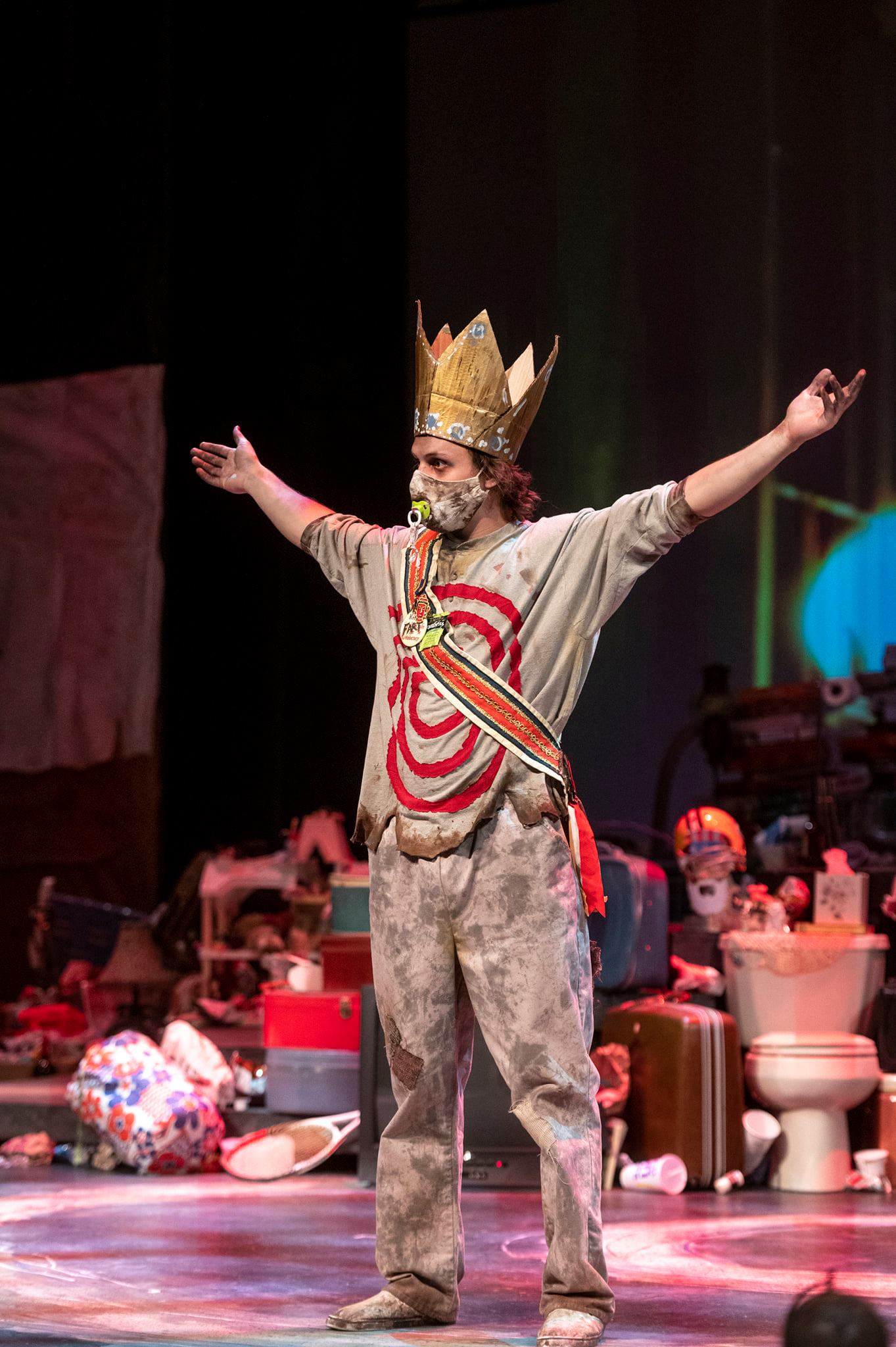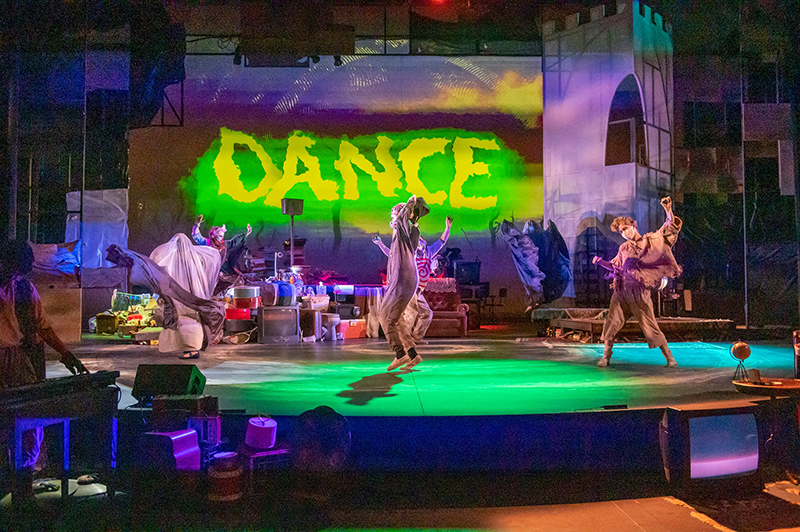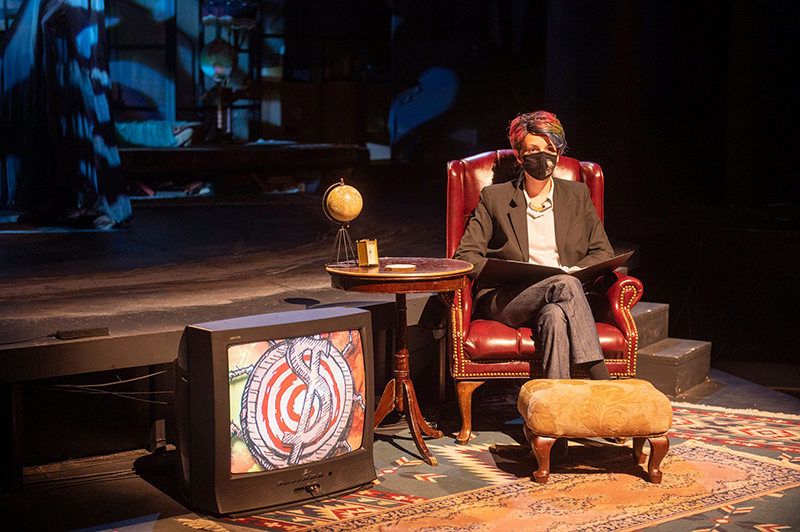Way back in the spring of 2020, the much anticipated production of Psh*tter! A Drinking Song for the Year of Our Lord 2020 lived to see one day on the Krannert Center stage before closing as a result of the shutdown. This “bawdy, bumpy rollercoaster” of a political mashup of of Shakespeare’s Macbeth and Alfred Jarry’s Ubu Roi, suited the times to a “t.” And now, returning as a filmed COVID-safe production, it seems even more of the moment. I’ve spilled a lot of digital “ink” tauting the resilience of artists and their determined spirit of innovation in the face of a challenge. And if ever there was an illustrative example, it is the return of Psh*tter. Curious to learn more about what this new production looked and felt like, I reached out to Genesee Spidco, Assistant Director, and Lecturer of Acting at the Illinois Theatre, and Theatre student Dane Brandon, Assistant Fight Choreographer and, wait for it, COVID monitor. Their experiences speak to the many challenges of making theatre possible in the middle of a pandemic. But. more importantly, they speak to our capacity to adapt and grow and overcome.
Smile Politely: How would you describe the play?
Genesee Spridco: It is a dark comedy looking at the corruptive quality of power. Henry Wishcamper created this adaptation that puts Macbeth and Ubu Roi and put them in a jagged blender. It’s irreverent and basks in its rawness. It switches between comedy styles that include commedia, clown, and that of Mel Brooks and Monty Python, but also has moments of grounding where we see the real ramifications to Daddy Ubu (and Momma Ubu’s) greed.
SP: What attracted you to it?
Spridco: It is a style of theatre that is not done very often. It is challenging and risky and a vast departure from the realism and naturalism that is found in Illinois Theatre’s repertoire. When Lisa had me read it, it was clear that the style of the piece
SP: It seems to be strangely appropriate for our times. Have you explored those parallels in your direction?
Spridco: In our initial table read, there was a lot of drawing parallels from the characters in political theatre. Wishcamper very much explains that any correlation is completely coincidental, but it is hard not to immediately connect to our lives in the moment. In fact with the remount, we added a bit of material that includes the new world we have slid into including the pandemic and recent emotional uprisings.

SP: Can you describe the process of reimagining the play for COVID times, in terms of direction and subtext?
Spridco: The actors in the first piece very much engaged a different style of theatre than the film version, we had to dial back the commedia style relationship to the audience to a much more specific playing with the camera as the audience. We reimagined the piece from a film perspective, including three different cameras and restaged the entire show to make sure we always maintained a six-foot distance. While doing that, we wanted to still make it feel a piece of theatre seamlessly integrating COVID precautions without necessarily making a display or a joke of it. It is part of the reality of the world of the play as much as it is a part of our reality. We had a long process of creating COVID precautions that would keep everyone safe, which included the costume designer coming back and creating character specific masks, which I think turned out so well.
SP: What have been the biggest challenges in coming back to the production?
Spridco: The limits of time is a big one. We were creating a new way of working which required more time, including a 15 minute break every hour where everyone needed to leave the space to make sure the air system could circulate effectively. It would halt momentum. We had to learn how to use those breaks effectively so we could come back ready for the next scene. Every film process goes longer than expected, but this film process required us to be done by a specific date as contracts required, also so the cameras could be available for November Dance, so we had no wiggle room. I am glad we reached our deadline, but it was a challenge indeed. This is not our usual medium and we all needed to pick up new skills quickly to make it successful.
SP: Have there been any surprises or silver linings about working in this new way?
Spridco: It has made us very aware of taking care of each other. We are even more attentive to the culture with which we make theatre and what of the ‘old normal’ can be scrapped from this experience.

SP: How do you and the actors compensate for the loss of a live audience and the energy they provide?
Spridco: It is a different energy, there is no substituting a full house of enthusiasm. But the cast played fully and the film crew were their pseudo audience and when we would call cut and a roll of laughter from the house would erupt, it helps our actors learn what comedy on a film shoot feels like.
SP: Those in the performing arts have been required to adapt and transform in order to keep their art form relevant and accessible under the limitations COVID has caused. But sometimes this can inspire creativity and innovation, particularly now that we have so much technology at our disposal. How are the students feeling about this landscape theatre finds itself in? How are classes and expectations adapting?
Spridco: It is a challenge for sure and each student is taking it in their individual ways. Some are finding more resilience and others are needing to really dig deep into why they want to do theatre. For sure, the students entering this industry will be cut from a different metal than our industry has experienced before. They are learning to articulate through layers of fabric. They are learning to build a relationship with a camera. They are learning kinesthetic awareness to give 6’ distance. They are adapting and running uphill the whole way. I like to think of this time as like when a swimmer is training. There is a process where a swimmer will attach a bucket to themselves, giving a significant amount of drag to their journey. It is hard. But the moment the bucket is released, the swimmer enjoys the strength and new speed they have created for themselves in the challenge. That is what this theatre making time is. A big bucket that is a drag now, but when we evolve past this, it will make us all the stronger for it.
Yes, we definitely had some challenges with the pandemic. It was very important to us that we follow the CDC, Illinois, and university guidelines. On top of that, we also used a lot of protocols that Actors Equity Association, the professional union for theatre actors and stage managers, have put in place. The main thing was that we insisted no actors need ever be within 6 feet of each other, and we had very strict guidelines in place as to how many people were allowed in the room at a time, as well as who was allowed to touch props and set pieces.

SP: Describe your experience as the play’s COVID monitor?
Dane Brandon: As the COVID monitor, I had a six foot long metal pole (affectionately referred to as the “Safety Stick)”, and for every new bit of staging, I would go up and make sure that that pole could fit between all of the actors onstage.
Sanitization was a surprisingly complicated issue. We came in with the basic guideline of “if it gets touched, it gets sanitized”. That proved much easier said than done. Initially, I was in charge of sanitizing all of the seats in the theater used by the creative team, and the actors were all in charge of their own props. The challenge was how to deal with the set. The set consists of a literal mountain of garbage with a tunnel running through it on one side of the stage, and a tower with a spiral staircase on the other. Needless to say, there was a lot of stuff that all the actors could interact with! Because we wanted to let the actors still be spontaneous onstage, there was really no way to tell what parts of the trash heap needed sanitized on any given night. The solution we landed on was giving every actor who interacted with the set their own spray sanitizer, and they were expected to spray down anything they touched at the end of rehearsal blocks.
Generally, our approach was to set a standard of respect for everyone’s safety, and give everyone the tools and procedures to do their part to keep their colleagues safe. My job slowly evolved from being the safety police to being a resource and advocate for everyone else in the room. I was the first point of contact for any questions, concerns, and feedback about the process.
SP: How did managing COVID restrictions dovetail with your role as Associate Fight Choreographer?
Brandon: Since the show is so violent (I want to say there are 8 fights throughout the 75-minute show), the biggest staging challenge as both the COVID Monitor and the Associate Fight Choreographer was: how do we communicate these fights without having any of the actors touch each other? The result was what Fight Choreographer David Sterritt and I called “violent clowning”. We relied a lot on camera tricks and the actors’ comedic skills to make the fights look cool and still tell a good story, all without the actors having to touch each other.
I think the guidelines we created, both before and during the process, were incredibly helpful. But the actors and stage management team deserve so much praise for saying “yes” to all of these new hoops they had to jump through. Mounting a play is already hard enough, but the whole team took all of these new challenges on the chin. The result was a space where I could still help make theatre, and honestly, I felt safer in rehearsal than in the grocery store.
SP: What has been the most rewarding aspect of this production for you personally?
Spridco: Getting to work with Lisa Dixon as her Associate Director. I learned a lot from the experience and I got to dig into some of my past experience in camera work. Also being able to reconnect with our recent alum who have come back for part two of the process. Seeing their investment in seeing this piece come to its fruition after the sudden spring shutdown was incredibly heartwarming.
SP: What are you most excited for audience members to experience?
Spridco: I think this this a very unique piece theatre told in a unique time in the world. I hope the audience finds the piece a cathartic laugh from the struggles we have endured.
SP: Anything else you’d like to share with our readers?
Spridco: Just a bit of serendipity: Psh*tter! is based of the French play, Ubu Roi, which closed the day it opened as it erupted in a riot. Our spring production lived for one day as well, closed from an oncoming pandemic. Hopefully the film version will last longer.
Psh*tter! A Drinking Song for the Year of Our Lord 2020
Available to view online mid-November
Stay tuned to the KCPA website and Facebook page for updates
All photos from Facebook
Editor’s note: Psh*tter! will be available for viewing from Thursday, December 3rd through Saturday, December 12th. Get more information here.








